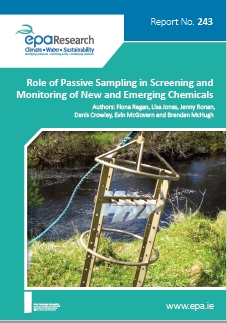Authors: Fiona Regan, Lisa Jones, Jenny Ronan, Denis Crowley, Evin McGovern and Brendan McHugh
Summary: Passive sampling (PS) techniques are rapidly developing as very cost-effective state-of-the-art tools for identifying and measuring ultra-trace micropollutants in water.

The aquatic environment – including lakes, rivers, ground water, estuaries and coastal zones – is vulnerable to changes caused by human activities. Accurately monitoring the status of water bodies under the EU Water Framework Directive (WFD) poses a huge challenge. One major difficulty is gathering representative information on levels of chemical contamination.
This project focused primarily on developing the capacity for using passive sampling in Ireland by exploring its applicability in relation to WFD requirements, and by documenting potential roles for passive sampling in Irish waters. Water and biota samples from 19 locations in five counties (Donegal, Mayo, Galway, Cork and Dublin) were taken, and passive samplers were deployed over three years. In Dublin and Cork, studies were carried out over two years to assess changes in chemical contamination over time. Analytical methods for pesticides, pharmaceuticals and non-polar organics were adapted for application to water, biota and passive sampler extracts.
Annex X to the WFD lists priority hazardous substances, a list that was updated and expanded in Directive 2013/39/EU to identify a number of emerging chemicals of concern, including some pesticides and biocides, industrial chemicals and endocrine disruptors. Although Member States can monitor priority substances in ‘whole’ water, biota or sediment, the environmental quality standards (EQSs) are primarily set for the water phase, as annual average and maximum allowable concentrations, although biota EQS have been established for 11 substances. This research suggests that passive sampling has more evident applicability in the marine environment, specifically in trend and offshore monitoring supporting both the tiered approach and the Marine Strategy Framework Directive (MSFD). In a wider context, as the biota EQS embrace other protection goals, such as protection of aquatic life, it is clear that passive sampling can still play a significant role in WFD monitoring. This project proposes a “framework tiered” approach that works with legislative requirements to capitalise on the strengths of passive sampling in monitoring WFD requirements.
The research findings suggest that it is theoretically possible to use passive sampling to screen for and measure the vast majority of organic compounds. However, several conditions must be met before passive sampling techniques can be considered fully suitable for routine monitoring. Their application for WFD purposes requires additional performance criteria. These include the calculation of accurate uptake rates to calculate time-weighted average contaminant concentrations in water, as well as strict protocols for in situ deployment.
There is a need for further discussion on a clear national strategy for applying passive sampling techniques as part of a tiered approach to water quality monitoring. A significant number of questions relating to the balance between scientific and practical considerations remain to be addressed. Ultimately, there is a need for consistency and comparability among Member States in the assessment of WFD compliance.
https://www.epa.ie/media/epa-2020/publications/research/Research_243_thumbnail[1].jpg